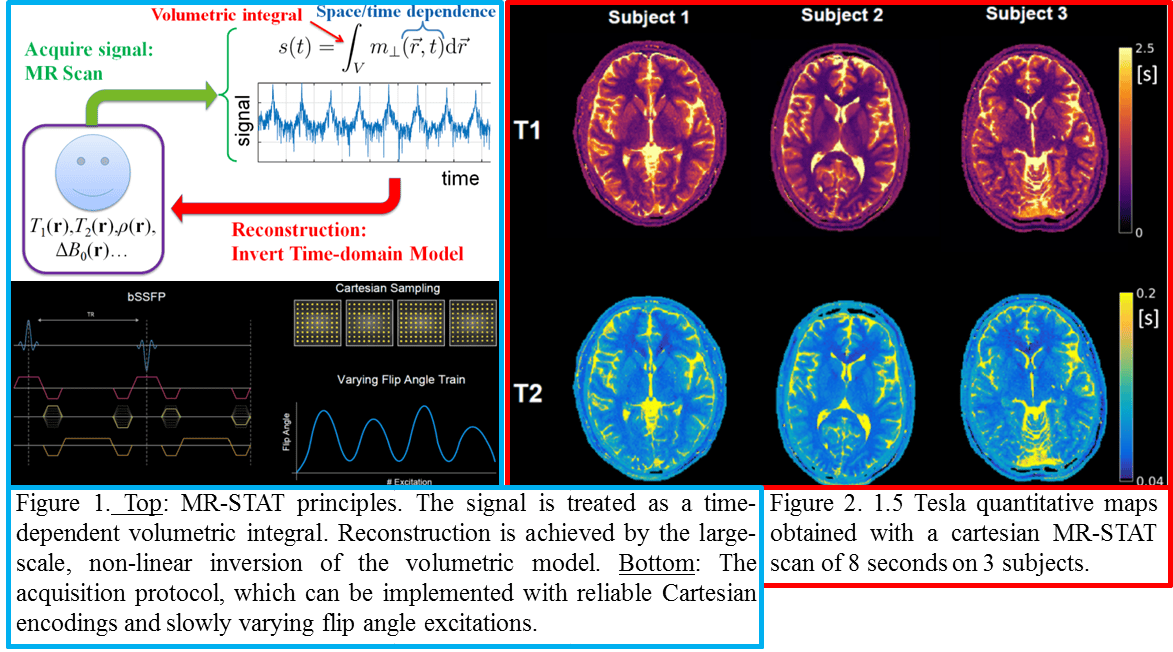
Description
Magnetic Resonance Spin TomogrAphy in Time-domain (MR-STAT) is a fast, multi-parametric technique which reconstruct all parameters of interest from a single short acquisition. In MR-STAT, the patient’s body is considered a large dynamical system which is probed in the time-domain by radiofrequency coils. Since the dynamic equations are well known (Faraday’s law and Bloch equation), reconstruction of the system parameters is carried out through the solution of a large-scale non-linear inversion problem directly from the time-domain data (Figure 1).

This approach allows for the spatial localization and the parameter quantification steps to be solved simultaneously. In standard qMRI, these steps are carried out subsequently, thus the spatial encoding scheme needs to fulfill either to Nyquist criteria (standard qMRI) or to certain types of incoherence (e.g. MR Fingerprinting) for a reliable reconstruction. The direct implication is that, in MR-STAT, acquisition is free from design constraints thus it can be carried out also with standard, reliable Cartesian encoding schemes. Another practical advantage of the MR-STAT approach is that all signal is fitted by a deterministic model (only the thermal noise is stochastic), thus large under-sampling artifacts are not present in MR-STAT (Figure 2). In addition, data reconstruction is performed iteratively, without the need of the pre-computed dictionary that hinders user adaptations in image protocols.
For more info check: www.umcutrecht.nl/MR-STAT.
Related publications
- Liu, H., Versteeg, E., Fuderer, M., van der Heide, O., Schilder, M. B., van den Berg, C. A., & Sbrizzi, A. (2024). Time‐efficient, high‐resolution 3T whole‐brain relaxometry using Cartesian 3D MR Spin TomogrAphy in Time‐Domain (MR‐STAT) with cerebrospinal fluid suppression. Magnetic Resonance in Medicine.
- van der Heide, O., van den Berg, C. A., & Sbrizzi, A. (2024). GPU‐accelerated Bloch simulations and MR‐STAT reconstructions using the Julia programming language. Magnetic Resonance in Medicine.
- Versteeg, E., Liu, H., van der Heide, O., Fuderer, M., van den Berg, C. A., & Sbrizzi, A. (2024). High SNR full brain relaxometry at 7T by accelerated MR‐STAT. Magnetic Resonance in Medicine.
- Liu, H., van der Heide, O., Versteeg, E., Froeling, M., Fuderer, M., Xu, F., … & Sbrizzi, A. (2024). A three‐dimensional Magnetic Resonance Spin Tomography in Time‐domain protocol for high‐resolution multiparametric quantitative magnetic resonance imaging. NMR in Biomedicine, 37(2), e5050.
- Fuderer, M., van der Heide, O., Liu, H., van den Berg, C. A., & Sbrizzi, A. (2024). Water diffusion and T2 quantification in transient‐state MRI: the effect of RF pulse sequence. NMR in Biomedicine, 37(1), e5044.
- van der Heide, O., Sbrizzi, A., & van den Berg, C. A. (2023). Cartesian vs radial MR-STAT: An efficiency and robustness study. Magnetic Resonance Imaging, 99, 7-19.
- Kleinloog, J. P., Mandija, S., D’Agata, F., Liu, H., van der Heide, O., Koktas, B., … & Sbrizzi, A. (2023). Synthetic MRI with magnetic resonance spin TomogrAphy in time‐domain (MR‐STAT): results from a prospective cross‐sectional clinical trial. Journal of Magnetic Resonance Imaging, 57(5), 1451-1461.
- Fuderer, M., van der Heide, O., Liu, H., van den Berg, C. A., & Sbrizzi, A. (2023). Efficient performance analysis and optimization of transient‐state sequences for multiparametric magnetic resonance imaging. NMR in Biomedicine, 36(3), e4864.
- Liu, H., van der Heide, O., van den Berg, C. A., & Sbrizzi, A. (2021). Fast and accurate modeling of transient‐state, gradient‐spoiled sequences by recurrent neural networks. NMR in Biomedicine, 34(7), e4527.
- Liu, H., Van der Heide, O., Mandija, S., Van den Berg, C. A., & Sbrizzi, A. (2022). Acceleration Strategies for MR-STAT: Achieving High-Resolution Reconstructions on a Desktop PC within 3 minutes. IEEE Transactions on Medical Imaging. doi:10.1109/TMI.2022.3168436;
- Van der Heide, O., Sbrizzi, A., Luijten, P.R. and Van den Berg, C.A., (2020). High‐resolution in vivo MR‐STAT using a matrix‐free and parallelized reconstruction algorithm. NMR in Biomedicine, 33(4):e4251. https://doi.org/10.1002/nbm.4251;
- Van der Heide, O., Sbrizzi, A., Luijten, P.R. and Van den Berg, C.A., (2020). Accelerated MR-STAT reconstructions using sparse Hessian approximations. IEEE Trans Med Imag. 39(11): 3737-48. https://doi.org/10.1109/TMI.2020.3003893.
- Sbrizzi, A., Van der Heide, O., Cloos, M., Van der Toorn, A., Hoogduin, H., Luijten, P.R. and Van den Berg, C.A., (2018). Fast quantitative MRI as a nonlinear tomography problem. Mag Res Imag 46:56-63. https://doi.org/10.1016/j.mri.2017.10.015;
Grants
- NWO-Open Tech 2022-2026 (PI: Alessandro Sbrizzi)
- NWO-MVI 2021-2022 (PI: Alessandro Sbrizzi)
- NWO-HTSM 2020-2024 (PI: Alessandro Sbrizzi)
- NWO-Demonstrator 2018-2020 (PI: Alessandro Sbrizzi)
- NWO-VIDI 2015-2020 (PI: Nico van den Berg)









